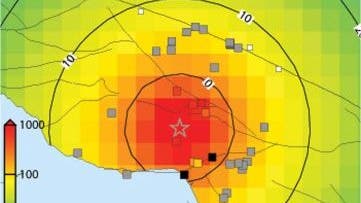Modellansatz: Linear Sampling

This is the first of three conversations recorded at the Conference on mathematics of wave phenomena, 23-27 July 2018 in Karlsruhe. Gudrun talked to Fioralba Cakoni about the Linear Sampling Method and Scattering.
The linear sampling method is a method to reconstruct the shape of an obstacle without a prior knowledge of either the physical properties or the number of disconnected components of the scatterer. The principal problem is to detect objects inside an object without seeing it with our eyes. So we send waves of a certain frequency range into an object and then measure the response on the surface of the body. The waves can be absorbed, reflected and scattered inside the body. From this answer we would like to detect if there is something like a tumor inside the body and if yes where. Or to be more precise what is the shape of the tumor. Since the problem is non-linear and ill posed this is a difficult question and needs several mathematical steps on the analytical as well as the numerical side.
In 1996 Colton and Kirsch (reference below) proposed a new method for the obstacle reconstruction problem in inverse scattering which is today known as the linear sampling method. It is a method to solve the above stated problem, which scientists call an inverse scattering problem. The method of linear sampling combines the answers to lots of frequencies but stays linear. So the problem in itself is not approximated but the interpretation of the response is.
The central idea is to invert a bounded operator which is constructed with the help of the integral over the boundary of the body.
Fioralba got her Diploma (honor’s program) and her Master's in Mathematics at the University of Tirana. For her Ph.D. she worked with George Dassios from the University of Patras but stayed at the University of Tirana. After that she worked with Wolfgang Wendland at the University of Stuttgart as Alexander von Humboldt Research Fellow. During her second year in Stuttgart she got a position at the University of Delaware in Newark. Since 2015 she has been Professor at Rutgers University. She works at the Campus in Piscataway near New Brunswick (New Jersey).
References
- F. Cakoni, D. Colton and H. Haddar, Inverse Scattering Theory and Transmission Eigenvalues, CBMS-NSF Regional Conference Series in Applied Mathematics, 88, SIAM Publications, 2016.
- F. Cakoni, D. Colton, A Qualitative Approach to Inverse Scattering Theory, Springer, Applied Mathematical Series, Vol. 188, 2014.
- T. Arens: Why linear sampling works, Inverse Problems 20 163-173, 2003. https://doi.org/10.1088/0266-5611/20/1/010
- A. Kirsch: Characterization of the shape of a scattering obstacle using the spectral data of the far field operator, Inverse Problems 14 1489-512, 1998
- D. Colton, A. Kirsch: A simple method for solving inverse scattering problems in the resonance region, Inverse Problems 12 383-93, 1996.
Podcasts
- S. Fliss, G. Thäter: Transparent Boundaries. Conversation in the Modellansatz Podcast episode 75, Department of Mathematics, Karlsruhe Institute of Technology (KIT), 2015.
- M. Kray, G. Thäter: Splitting Waves. Conversation in the Modellansatz Podcast episode 62, Department of Mathematics, Karlsruhe Institute of Technology (KIT), 2015.
- F. Sayas, G. Thäter: Acoustic scattering. Conversation in the Modellansatz Podcast episode 58, Department of Mathematics, Karlsruhe Institute of Technology (KIT), 2015.
In den nächsten Wochen bis zum 20.2.2020 möchte Anna Hein, Studentin der Wissenschaftskommunikation am KIT, eine Studie im Rahmen ihrer Masterarbeit über den Podcast Modellansatz durchführen. Dazu möchte sie gerne einige Interviews mit Ihnen, den Hörerinnen und Hörern des Podcast Modellansatz führen, um herauszufinden, wer den Podcast hört und wie und wofür er genutzt wird. Die Interviews werden anonymisiert und werden jeweils circa 15 Minuten in Anspruch nehmen. Für die Teilnahme an der Studie können Sie sich bis zum 20.2.2020 unter der Emailadresse studie.modellansatz@web.de bei Anna Hein melden. Wir würden uns sehr freuen, wenn sich viele Interessenten melden würden.
In the coming weeks until February 20, 2020, Anna Hein, student of science communication at KIT, intends to conduct a study on the Modellansatz Podcast within her master's thesis. For this purpose, she would like to conduct some interviews with you, the listeners of the Modellansatz Podcast, to find out who listens to the podcast and how and for what purpose it is used. The interviews will be anonymous and will take about 15 minutes each. To participate in the study, you can register with Anna Hein until 20.2.2020 at studie.modellansatz@web.de . We would be very pleased if many interested parties would contact us.



Wenn Sie inhaltliche Anmerkungen zu diesem Artikel haben, können Sie die Redaktion per E-Mail informieren. Wir lesen Ihre Zuschrift, bitten jedoch um Verständnis, dass wir nicht jede beantworten können.